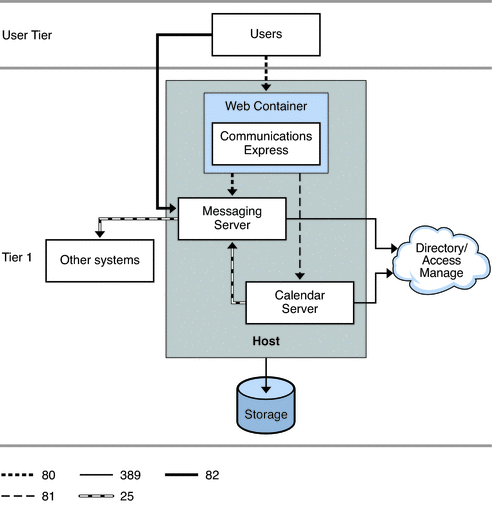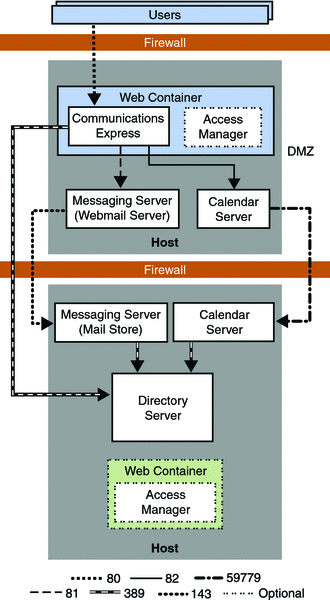Part V Deploying Communications Express
This part contains the following chapters:
Chapter 23 Introduction to Communications Express Software
Communications Express provides an integrated web-based communications and collaboration client. Communications Express is a common component of Messaging Server and Calendar Server, providing end users with a web interface to their calendar information and mail, as well as an address book.
Communications Express consists of three client modules: Calendar, Address Book, and Mail.
This chapter contains the following sections:
Communications Express Overview
Communications Express depends upon the following Sun Java System component products:
-
Directory Server
-
Access Manager (if you are using Sun Java System LDAP Schema Version 2)
-
Calendar Server
-
Messaging Server
You install Communications Express as a front-end server (in a multi-tier environment). The Messaging Server packages can then be configured to run as Webmail server, which connects to a back-end store running Webmail server. Also, both Communications Express and Messenger Express can run on different IP addresses.
In addition, you can configure Communications Express to have the Address Book on the front-end machine store its data either in the LDAP directory infrastructure or on an LDAP server other than the Communications Express machine. See the Sun Java System Communications Express 6.3 Administration Guide for more information.
Communications Express communicates with Calendar Server through the Calendar Server HTTP service, the mshttpd daemons for Messaging Server, and the LDAP service for address book. The cshttpd daemon, the mshttpd daemon can be local or remote, and the LDAP service can all be either local or remote.
When using a load balancer or port director type device, make sure to utilize “sticky” (persistent) connections such that users are continually routed to the same front-end server for the duration of their session.
Communications Express Features
-
Communications Express has an integrated user interface for calendar, mail, and address book and enables the access of one client module from another without re-authenticating user credentials.
-
Communication between mail and calendar is automatically established because both applications are deployed within a single web container. Also, you can optionally use Access Manager to provide the single sign-on mechanism.
-
Both calendar and mail applications share the same address book.
-
All modules share the common user preferences specified in the Options tab of Communications Express.
-
The Address Book Store provides horizontal scalability. See the Sun Java System Communications Express 6.3 Administration Guide for more information.
-
Communications Express supports virtual domains.
Communications Express High-Level Architecture
The Calendar and Address Book client modules are deployed as a single web application in any web container. The mail module is rendered by the Messenger Express. Messenger Express is the standalone web interface mail application that uses the HTTP service of the Messaging Server.
Figure 23–1 shows the Communications Express software architecture.
Figure 23–1 High Level Communications Express Software Architecture

Communications Express consists of the following modules:
-
Mail. The Mail component uses the JavaScript language that is read and interpreted by the client. The JavaScript files are located on the server and downloaded to the client. The client extracts data from the JavaScript code to customize Communications Express functions. All modifications and customizations are done on the server.
-
Calendar. The presentation layer of the Calendar module is based on JavaServer PagesTM. These JavaServer Pages pages can be customized to suit the requirements of the client. The data layer accesses a Java API for Calendar (JCAPI) to enable exchange of data with Calendar Server over HTTP-based protocol.
-
Address Book. The Address Book component uses XML/XSL files that contain XSL tags, static HTML and .js scripts. The XSL and JavaScript code are used to display dynamic data. These XSL files can be edited for customizing the Address Book component.
Chapter 24 Developing a Communications Express Architecture
This chapter contains Communications Express basic deployment architectures. Depending on the features you want to implement in your deployment, you will need to install different sets of hosts and other networking infrastructure.
This chapter contains the following sections:
Basic Communications Express Architecture
This basic Communications Express architecture provides Calendar, Address Book, and Mail modules in a web container on a single host. Messenger Express is the standalone web interface mail application that uses the HTTP service of the Messaging Server. Messenger Express is deployed on the same system as the Calendar and Address Book modules.
To provide this basic functionality, you need to install the following components:
-
Directory Server
-
Access Manager (If you are using Sun Java System LDAP Schema Version 2)
-
Calendar Server
-
Messaging Server
-
Web Server or Application Server (for the web container)
In this example:
-
You install the complete set of Messaging Server packages on the host that Communications Express is running on.
-
The AddressBook server of Communications Express is configured to store its data in the LDAP directory infrastructure.
-
SSL has not been configured.
Figure 24–1 shows the basic Communications Express architecture.
Figure 24–1 Basic Communications Express Architecture

The following table explains the protocols and port numbers used by this architecture.
Table 24–1 Protocols And Ports Used by Basic Communications Express Deployment Architecture|
Protocol |
Port |
Used By |
|---|---|---|
|
SMTP |
25 |
Messaging Server MTA component to communicate with other systems, and Calendar Server (csenpd) components for email notifications |
|
HTTP |
80 |
Internet users to communicate with Communications Express front-end, and Communications Express to communicate with Messaging Server |
|
HTTP |
81 |
Calendar Express on Communications Express to communicate with Calendar Server |
|
MSHTTP |
82 |
Internet users to communicate with Messenger Express |
|
LDAP |
389 |
Messaging Server and Calendar Server to communicate with LDAP directory |
Communications Express on Remote Host Architecture
Figure 24–2 shows a Communications Express architecture where both intranet and Internet users log on to Communications Express on the front-end host, which accesses the back-end host on the user's behalf. You can enable SSO on the front-end host such that Communications Express validates the session in Access Manager.
You install the front-end host with the following components:
-
Messaging Server (Webmail Server)
-
Web container
-
(Optional) Access Manager SDK
-
Communications Express
You install the back-end with the following components:
-
Directory Server
-
Messaging Server (Mail Store)
-
Calendar Server
-
(Optional) Web Container and Access Manager
Figure 24–2 shows the Communications Express on remote host architecture.
Figure 24–2 Communications Express on Remote Host Architecture

The following table explains the protocols and port numbers used by this architecture.
Table 24–2 Protocols And Ports Used by Communications Express Remote Host Deployment Example|
Protocol |
Port |
Used By |
|---|---|---|
|
HTTP |
80 |
Users to communicate with Communications Express on the front-end host in the DMZ |
|
HTTP |
81 |
Communications Express on the front-end host in the DMZ to communicate with Webmail Server also on the front-end host |
|
HTTP |
82 |
Communications Express on the front-end host in the DMZ to communicate with Calendar Server also on the front-end host |
|
IMAP |
143 |
Webmail Server on the front-end host in the DMZ to communicate with Messaging Server on the back-end host |
|
LDAP |
389 |
Messaging Server, Calendar Server, and Communications Express to communicate with LDAP directory |
|
WCAP |
59779 |
Calendar Server on the front-end host in the DMZ to communicate with Calendar Server on the back-end host |
- © 2010, Oracle Corporation and/or its affiliates
